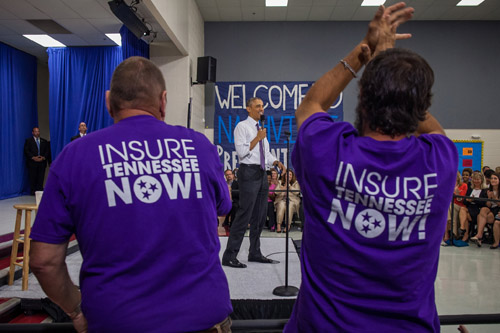Health insurance companies around the country are seeking rate increases of 20 percent to 40 percent or more, saying their new customers under the Affordable Care Act turned out to be sicker than expected. Federal officials say they are determined to see that the requests are scaled back.

Blue Cross and Blue Shield plans – market leaders in many states – are seeking rate increases that average 36 percent in Tennessee and more in other states (54% increase in Minnesota), according to documents posted online by the federal government and state insurance commissioners and interviews with insurance executives.
Jesse Ellis O’Brien, a health advocate at the Oregon State Public Interest Research Group, said: “Rate increases will be bigger in 2016 than they have been for years and years and will have a profound effect on consumers here. Some may start wondering if insurance is affordable or if it’s worth the money.”
President Obama was in Nashville last week and said that consumers should put pressure on state insurance regulators to scrutinize the proposed rate increases. If commissioners do their job and actively review rates, he said, “my expectation is that they’ll come in significantly lower than what’s being requested.”
 The rate requests, from some of the more popular health plans, suggest that insurance markets are still adjusting to shock waves set off by the Affordable Care Act.
The rate requests, from some of the more popular health plans, suggest that insurance markets are still adjusting to shock waves set off by the Affordable Care Act.It is far from certain how many of the rate increases will hold up on review, or how much they might change. But already the proposals, buttressed with reams of actuarial data, are fueling fierce debate about the effectiveness of the health law.
A study of 11 cities in different states by the Kaiser Family Foundation found that consumers would see relatively modest increases in premiums if they were willing to switch plans. But if they switch plans, consumers would have no guarantee that they can keep their doctors. And to get low premiums, they sometimes need to accept a more limited choice of doctors and hospitals.
Some say the marketplaces have not attracted enough healthy young people. “As a result, millions of people will face Obamacare sticker shock,” said Senator John Barrasso, Republican of Wyoming.
Sylvia Mathews Burwell, the secretary of health and human services, said that federal subsidies would soften the impact of any rate increases. Of the 10.2 million people who obtained coverage through federal and state marketplaces this year, 85 percent receive subsidies in the form of tax credits to help pay premiums.
In an interview, Ms. Burwell said consumers could also try to find less expensive plans in the open enrollment period that begins in November. “You have a marketplace where there is competition,” she said, “and people can shop for the plan that best meets their needs in terms of quality and price.”
In their submissions to federal and state regulators, insurers cite several reasons for big rate increases. These include the needs of consumers, some of whom were previously uninsured; the high cost of specialty drugs; and a policy adopted by the Obama administration in late 2013 that allowed some people to keep insurance that did not meet new federal standards.
“Healthier people chose to keep their plans,” said Amy L. Bowen, a spokeswoman for the Geisinger Health Plan in Pennsylvania, and people buying insurance on the exchange were therefore sicker than expected. Geisinger, often praised as a national model of coordinated care, has requested an increase of 40 percent in rates for its health maintenance organization.
Insurers with decades of experience and brand-new plans underestimated claims costs.
“Our enrollees generated 24 percent more claims than we thought they would when we set our 2014 rates,” said Nathan T. Johns, the chief financial officer of Arches Health Plan, which covers about one-fourth of the people who bought insurance through the federal exchange in Utah. As a result, the company said, it collected premiums of $39.7 million and had claims of $56.3 million in 2014. It has requested rate increases averaging 45 percent for 2016.
The rate requests are the first to reflect a full year of experience with the new insurance exchanges and federal standards that require insurers to accept all applicants, without charging higher prices because of a person’s illness or disability. The 2010 health law established the rate review process, requiring insurance companies to disclose and justify large proposed increases. Under federal rules, increases of 10 percent or more are subject to review.
Federal officials have often highlighted a provision of the Affordable Care Act that caps insurers’ profits and requires them to spend at least 80 percent of premiums on medical care and related activities. “Because of the Affordable Care Act,” Mr. Obama told supporters in 2013, “insurance companies have to spend at least 80 percent of every dollar that you pay in premiums on your health care – not on overhead, not on profits, but on you.”
BlueCross BlueShield of Tennessee, the largest insurer in the state’s individual market, said its proposed increase of 36 percent could affect more than 209,000 consumers.
“There’s not a lot of mystery to it,” said Roy Vaughn, a vice president of the Tennessee Blue Cross plan. “We lost a significant amount of money in the marketplace, $141 million, because we were not very accurate in predicting the utilization of health care.”
Julie Mix McPeak, the Tennessee insurance commissioner, said she would ask “hard questions of the companies we regulate, to protect consumers.”
We’ve had several calls lately from our customers insured with Assurant Health / Time Insurance Company. This 100+ year company decided in the last 90 days that they are pulling out of the healthcare insurance market – a tragic result of not being able to survive in this healthcare marketplace. There are solutions for those insured’s as they deal with a transition to the affordable healthcare program. We’re here to help and can offer solutions for coverage either on a short term or long term basis. Contact our staff at 615.377.1212 or EMAIL us at info@BentonWhite.com
(Credit: Segments of this article are reprinted from New York Times article – July 3, 2015)





